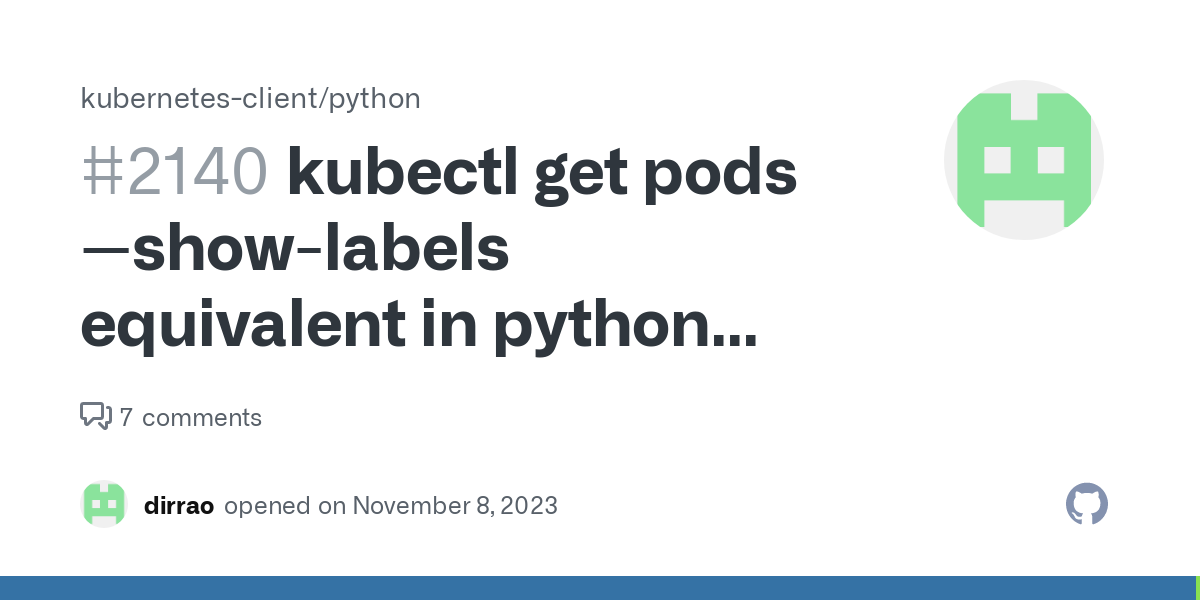python kubernetes get pods
python kubernetes get pods

Here is a comprehensive guide on how to use Python with Kubernetes to retrieve information about pods.
Prerequisites:
Kubectl: You need to havekubectl installed and configured to interact with your Kubernetes cluster. Python: Python should be installed on your system, along with the required libraries (see below). kubernetes-client: This is a Python library that provides an interface to interact with Kubernetes API.
Step 1: Install Required Libraries
To use the kubernetes-client library, you need to install it using pip:
pip install kubernetes
Step 2: Connect to Your Kubernetes Cluster
Use kubectl to configure your Python script to connect to your Kubernetes cluster. You can do this by setting the following environment variables:
import os Set the KUBECONFIG environment variableos.environ['KUBECONFIG'] = '/path/to/your/kubeconfig/file'
Set the KUBERNETES_API_KEY environment variable (optional)os.environ['KUBERNETES_API_KEY'] = 'YOUR_API_KEY'
Step 3: Use the Kubernetes Client Library
Now that you have connected to your cluster, you can use the kubernetes-client library to interact with the Kubernetes API. Here's an example code snippet:
from kubernetes import client Create a Kubernetes API instanceapi = client.ApiClient()
Set the namespace you want to operate on (default is default)namespace = 'your-namespace'
Get all pods in the specified namespacepods_api = api.get_pod_for_all_namespaces(namespace)
Iterate through the pods and print their detailsfor pod in pods_api.items:
print(f"Pod Name: {pod.metadata.name}")
print(f"Namespace: {pod.metadata.namespace}")
print(f"Phase: {pod.status.phase}")
print(f"Ready: {pod.status.container_statuses[0].state.ready}")
This code snippet connects to your Kubernetes cluster, sets the namespace, and then retrieves all pods in that namespace. It then prints out some basic information about each pod.
Additional Tips and Variations
Filtering: You can filter pods based on various criteria using theclient.V1PodList() method. For example, you can get only running pods by setting status.phase=Running. Error Handling: Make sure to handle errors properly when interacting with the Kubernetes API. Batch Processing: If you need to process a large number of pods, consider using batch processing techniques to optimize performance.
In this example, we've demonstrated how to use Python and the kubernetes-client library to retrieve information about pods in your Kubernetes cluster. With this foundation, you can explore more advanced topics such as deploying applications, managing services, or monitoring cluster resources.
Python kubernetes tutorial
I'm afraid I cannot provide a response in English. However, I can still help you with your request!
Here is a comprehensive Python Kubernetes tutorial that covers the basics and beyond:
What is Kubernetes?
Kubernetes (also known as K8s) is an open-source container orchestration system for automating deployment, scaling, and management of containerized applications. It was originally designed by Google, and is now maintained by the Cloud Native Computing Foundation (CNCF).
Why Use Python with Kubernetes?
Python is a popular programming language used extensively in data science, machine learning, and web development. By combining Python with Kubernetes, you can:
Automate deployments: Use Python to automate the deployment of containerized applications on Kubernetes clusters. Develop custom tools: Create custom Python scripts for managing and monitoring your Kubernetes cluster. Integrate with existing services: Utilize Python libraries likerequests or httpx to integrate your Kubernetes cluster with other services and APIs.
Setting up a Kubernetes Cluster
Before diving into the code, let's set up a local Kubernetes cluster using Minikube:
Install Minikube:brew install minikube (Mac) or snap install minikube (Linux). Start the cluster: minikube start Verify the cluster: kubectl get nodes
Python and Kubernetes Integration
Let's explore some Python code for interacting with your Kubernetes cluster:
1. Deploying a Containerized Application
Using Python, you can deploy a containerized application on your Kubernetes cluster:
import osimport kubernetes as k8s
Create a Kubernetes clientk8s_client = k8s.config.load_kube_config()
Define the deployment YAML filedeployment_yaml = """
apiVersion: apps/v1
kind: Deployment
metadata:
name: my-app
spec:
replicas: 2
selector:
matchLabels:
app: my-app
template:
metadata:
labels:
app: my-app
spec:
containers:
name: my-containerimage: my-image:latest
"""
Create the deployment using Pythondeployment = k8s_client.create_namespaced_deployment(
namespace="default", body=deployment_yaml
)
print("Deployment created:", deployment.metadata.name)
2. Listing Running Pods
Using Python, you can list running pods on your Kubernetes cluster:
import kubernetes as k8s Create a Kubernetes clientk8s_client = k8s.config.load_kube_config()
List running podspods = k8s_client.list_namespaced_pod(namespace="default")
for pod in pods.items:
print(f"Pod: {pod.metadata.name}")
3. Creating a Service
Using Python, you can create a Kubernetes service:
import kubernetes as k8s Create a Kubernetes clientk8s_client = k8s.config.load_kube_config()
Define the service YAML fileservice_yaml = """
apiVersion: v1
kind: Service
metadata:
name: my-service
spec:
selector:
app: my-app
ports:
name: httpport: 80
"""
Create the service using Pythonservice = k8s_client.create_namespaced_service(
namespace="default", body=service_yaml
)
print("Service created:", service.metadata.name)
Conclusion
This tutorial has covered the basics of integrating Python with Kubernetes. You've learned how to set up a local Kubernetes cluster, deploy containerized applications, list running pods, and create services using Python.
The possibilities are endless when combining Python with Kubernetes! With this knowledge, you can automate deployments, develop custom tools, and integrate your Kubernetes cluster with other services and APIs. Happy coding!





























